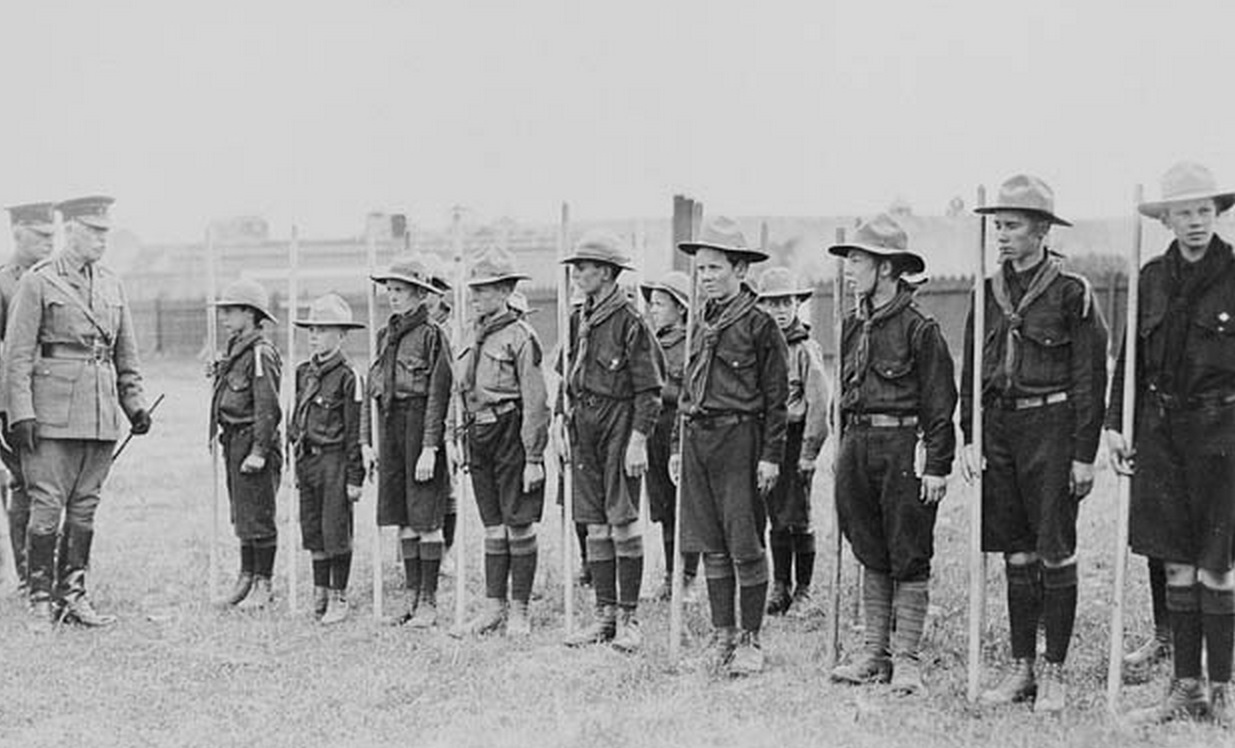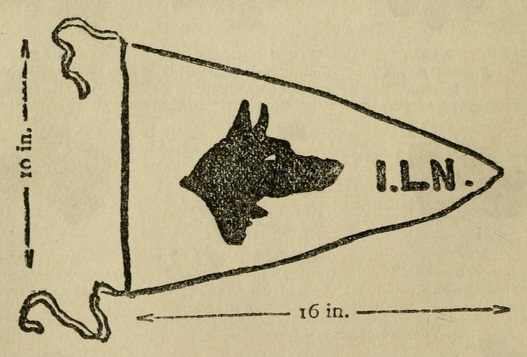Scout staff on:
[Wikipedia]
[Google]
[Amazon]
A Scout staff (or Scout stave) is a shoulder-high wooden pole or
 When
When
The Boy Scouts' Association, The Canadian General Council, 1919 (p. 13) Patrol Leaders carried a white pennant on their staves, showing a
quarterstaff
A quarterstaff (plural quarterstaffs or quarterstaves), also short staff or simply staff is a traditional European pole weapon, which was especially prominent in England during the Early Modern period.
The term is generally accepted to refer t ...
, traditionally carried by Boy Scout
A Scout (in some countries a Boy Scout, Girl Scout, or Pathfinder) is a child, usually 10–18 years of age, participating in the worldwide Scouting movement. Because of the large age and development span, many Scouting associations have split ...
s as part of their accoutrements. Its main purpose was as a walking stick
A walking stick or walking cane is a device used primarily to aid walking, provide postural stability or support, or assist in maintaining a good posture. Some designs also serve as a fashion accessory, or are used for self-defense.
Walking s ...
or Trekking pole
Trekking poles (also known as hiking poles, hiking sticks or walking poles) are a common hiking accessory that function to assist walkers with their rhythm, to provide stability, and reduce strain on joints on rough terrain.
Description
When in ...
, but it had a number of other uses in emergency situations and can be used for Scout pioneering.
History
 When
When Robert Baden-Powell
Lieutenant-General Robert Stephenson Smyth Baden-Powell, 1st Baron Baden-Powell, ( ; (Commonly pronounced by others as ) 22 February 1857 – 8 January 1941) was a British Army officer, writer, founder and first Chief Scout of the wor ...
devised his scheme of Scout
Scout may refer to:
Youth movement
* Scout (Scouting), a child, usually 10–18 years of age, participating in the worldwide Scouting movement
**Scouts (The Scout Association), section for 10-14 year olds in the United Kingdom
** Scouts BSA, sect ...
citizenship training for boys, published in 1908 in ''Scouting for Boys
''Scouting for Boys: A handbook for instruction in good citizenship'' is a book on Boy Scout training, published in various editions since 1908. Early editions were written and illustrated by Robert Baden-Powell with later editions being extens ...
'', he recommended that Scouts should carry "a strong stick, about as high as your nose, marked in feet and inches for measuring". After listing the various uses to which the staff could be put, he added "If you get the chance, cut your own staff, but remember to get permission first". It was said to have been based on a staff used by a Royal Engineers officer during the Fourth Anglo-Ashanti War
The Anglo-Ashanti wars were a series of five conflicts that took place between 1824 and 1900 between the Ashanti Empire—in the Akan interior of the Gold Coast—and the British Empire and its African allies. Though the Ashanti emerged victori ...
. In August 1917, Baden-Powell wrote a critical article in the Headquarters Gazette
''Scouting'' magazine was a bi-monthly publication of The Scout Association. The magazine included information, resources and support for both young people and adults involved with The Scout Association and Scouting. It was supplied free of direct ...
about "the matter of Scouts being allowed to parade without their staffs, which for several reasons is regrettable". In the same article, he lists the cultural roots of the Scout staff which he claimed were "the scouts of Cuhulain armed with staffs, the pilgrims... with their cockle-shells and staffs, the 'prentice bands of London with their cloth yards and their staffs, the merry men of Robin Hood
Robin Hood is a legendary heroic outlaw originally depicted in English folklore and subsequently featured in literature and film. According to legend, he was a highly skilled archer and swordsman. In some versions of the legend, he is de ...
with bows and quarter staffs, down to the present-day mountaineers, war-scouts, and explorers".
At the 3rd World Scout Jamboree
The 3rd World Scout Jamboree was held in 1929 at Arrowe Park in Upton, near Birkenhead, Wirral, United Kingdom. As it was commemorating the 21st birthday of ''Scouting for Boys'' and the Scouting movement, it is also known as the Coming of Age ...
in 1929, French Scouts constructed an replica of the Eiffel Tower
The Eiffel Tower ( ; french: links=yes, tour Eiffel ) is a wrought-iron lattice tower on the Champ de Mars in Paris, France. It is named after the engineer Gustave Eiffel, whose company designed and built the tower.
Locally nickname ...
constructed entirely of lashed Scout staves.
In the United Kingdom, the cost and awkwardness of the staff meant that it became common for Scout Troops to hold a stock of staves in their meeting place, rather than have Scouts carry them about. The final blow came with the 1966 ''Advance Party Report'', which recommended that "With the exception of a knife, no present optional items of uniform (e.g. staff, thumbstick, haversack.... ) may in future be worn".
Description
The official ''Policy, Organization and Rules'' of theBoy Scouts Association
The Scout Association is the largest Scouting organisation in the United Kingdom and is the World Organization of the Scout Movement's recognised member for the United Kingdom. Following the origin of Scouting in 1907, the association was form ...
(UK) stipulated that the staff must be "Marked in feet and inches, in length".''Policy, Organization and Rules for Canada''The Boy Scouts' Association, The Canadian General Council, 1919 (p. 13) Patrol Leaders carried a white pennant on their staves, showing a
silhouette
A silhouette ( , ) is the image of a person, animal, object or scene represented as a solid shape of a single colour, usually black, with its edges matching the outline of the subject. The interior of a silhouette is featureless, and the silhou ...
of their Patrol animal (each Patrol was named after an animal or bird). Modern commercially produced Scout staves are still available in the United Kingdom, generally made from coppice
Coppicing is a traditional method of woodland management which exploits the capacity of many species of trees to put out new shoots from their stump or roots if cut down. In a coppiced wood, which is called a copse, young tree stems are repea ...
grown ash
Ash or ashes are the solid remnants of fires. Specifically, ''ash'' refers to all non-aqueous, non- gaseous residues that remain after something burns. In analytical chemistry, to analyse the mineral and metal content of chemical samples, ash ...
.

Uses
Some uses of the Scout staff that have been recommended by various Scouting publications: * Making an improvisedstretcher
A stretcher, gurney, litter, or pram is an apparatus used for moving patients who require medical care. A basic type (cot or litter) must be carried by two or more people. A wheeled stretcher (known as a gurney, trolley, bed or cart) is often ...
* Holding back a crowd
* Jumping over a ditch (pole vault
Pole vaulting, also known as pole jumping, is a track and field event in which an athlete uses a long and flexible pole, usually made from fiberglass or carbon fiber, as an aid to jump over a bar. Pole jumping competitions were known to the My ...
)
* Testing the depth of a river
* Helping another Scout over a high wall
* Construction of a light bridge, hut or flag staff
* Stopping a car by jamming a staff through the spokes of the wheel
* Self-defence
* A tent pole for a small tent
* Feeling your way over rough or marshy ground
* Measuring distances
* Estimating the height of trees or tall buildings
* Linking Scouts together on a night hike
* Making a splint for an injured leg
* Stopping an aggressive dog
* Beating out bush fires
References
{{reflist Hiking equipment Scouting uniform Scoutcraft Walking sticks